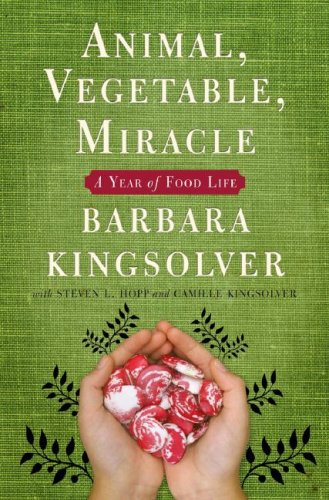 The Kingsolver-Hopp family left their home in Arizona to do something few other modern American families have tried: they went on a mission to feed themselves for a year on things grown entirely on their own farm or things they could access locally. They moved across the country to Virginia in order to embark on this adventure.
The Kingsolver-Hopp family left their home in Arizona to do something few other modern American families have tried: they went on a mission to feed themselves for a year on things grown entirely on their own farm or things they could access locally. They moved across the country to Virginia in order to embark on this adventure.Animal, Vegetable, Miracle is the story of that year, told from the perspective of bestselling author Barbara Kingsolver. Her husband, a biologist, provides articles of interest on topics relating to particular sections of the book. Her daughter also provides a teenager's perspective in her essays included throughout the book, as well as recipes for the seasonal goodies they grow and harvest.
The Kingsolver-Hopps had long been aware of what they ate; they stopped eating beef bred on so-called factory farms almost a decade before their journey to Virginia. She states in the book that in their hometown of Tucson, Arizona, this basically meant becoming vegetarians. They spent vacations and breaks on their farm in Virginia prior to their permanent move. At some point or another, they decided the Arizona desert was not the place to try your hand at food independence. Thus, their move cross-country.
Even though I have lately become a nonfiction reader, I usually stick to memoirs both sad and funny. This is neither, and reads almost more as a series of magazine articles devoted to organic farming -- nothing I would normally be interested in. But
 maybe because of my own growing interest in eating "better" (whatever that may mean), maybe my own childhood spent on a beef cattle farm, maybe because my brother and sister-in-law are now living as missionaries in Africa with a focus on teaching native Africans skills of sustainable living. I'm not sure which if these (or maybe all of them) contributed to my continued interest in the book, but interest was certainly there. It took me the better part of a week to get through it; there was a plot, albeit a small one -- the story of how this new life affected this family.
maybe because of my own growing interest in eating "better" (whatever that may mean), maybe my own childhood spent on a beef cattle farm, maybe because my brother and sister-in-law are now living as missionaries in Africa with a focus on teaching native Africans skills of sustainable living. I'm not sure which if these (or maybe all of them) contributed to my continued interest in the book, but interest was certainly there. It took me the better part of a week to get through it; there was a plot, albeit a small one -- the story of how this new life affected this family.But most interesting to me was how and why they did it. Kingsolver includes long passages on everything from "harvesting" turkeys (yes, this is exactly what it sounds like) to planting tomatoes. On their website, they have even included an updated index organized by topic so that others can use the book as a reference guide for farming. Also plentiful in the book are Kingsolver's reasonings for their lifestyle change. Fossil fuels are depleted each time we bite into an avocado from Mexico or a pineapple grown in South America. Rather than spending money on items that show up on our grocery store shelf (strawberries in January, you might ask yourself?) oddly out of place, Kingsolver challenges her family -- and later her readers -- to give that money instead to local farmers at produce stands, at farmer's markets, and at the actual farms.
 I can't force you to change your ways... I, for one, happen to LIKE coffee imported from exotic locations. But Animal, Vegetable, Miracle has given me pause. I hope that it will influence me to make different choices -- and that I will at least take advantage of our local farmer's market during peak months rather than running into the closest Kroger for "fresh" corn. Kingsolver's book is interesting, if nothing else. Despite what might seem like preaching, she doesn't. She simply lays her thoughts out there for everyone to read, and lives her life as an example.
I can't force you to change your ways... I, for one, happen to LIKE coffee imported from exotic locations. But Animal, Vegetable, Miracle has given me pause. I hope that it will influence me to make different choices -- and that I will at least take advantage of our local farmer's market during peak months rather than running into the closest Kroger for "fresh" corn. Kingsolver's book is interesting, if nothing else. Despite what might seem like preaching, she doesn't. She simply lays her thoughts out there for everyone to read, and lives her life as an example.She also includes clever insights into the world of gardening and farming, one of the best being her concept of the "vegetannual", a plant created to explain the seasons of vegetables and fruit. The picture above bears the inscription: "Picture a single imaginary plant, bearing throughout the season all the different vegetables we harvest... we'll call it a vegetannual."

No comments:
Post a Comment